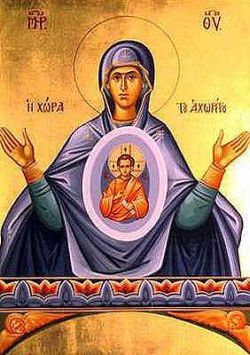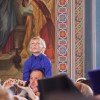Source: www.theologic.com/oflweb
The “More Spacious than the Heavens” icon is very prominent in an Orthodox church., perhaps because it expresses some of our Faith’s core beliefs, principally the willingness of our Mother, the Church, to receive us with her outstretched and waiting arms.
This icon often know by its Greek name of Platytera Ton Ouranon, or simply, Platytera. It is found in most Orthodox churches in an amazingly prominent position — high in the apse — and is often of such a scale that it overwhelms and overshadows in emphasis all other icons. This can present a rather odd first impression especially to a non-Orthodox visitor. Even to Orthodox it may present a bit of a dilemma. How is it that in a Christian church, a place where life centers around Christ, an image of His mother Mary would appear to have dominance? In reality there is an image of Christ, as Almighty, in a place of preeminence, in the honored position of the ceiling [or the dome, if the church building has one]. Secondly, Christ is found in the Platytera at bull’s eye center on Mary’s lap.

This shows a balance in the historical Church’s view of the place and role of Mary. She is essential and significant by her relationship to Christ. Christ could not have been born without her free consent. She is made significant by the One she bore. She provides the throne. She is in the background. These characteristics reveal her humility, and oddly enough the icon in its way glorifies her because of it.
She is significant to us as an example of the potential outcome of free-will submission to God’s goodness. She is indispensable because without her Christ’s birth could not have taken place. The architectural placement of the Platytera powerfully teaches that she is the person through whom heaven and earth are united, since this mural is where ceiling and floor meet. Her icon “unites” Christ’s ceiling icon with those of us standing on the ground.
With the coming of the Holy Spirit at Pentecost a remarkable thing happened: God revealed to mankind that everyone could have God dwelling in them. This was a radically different concept to the Jews of that day who saw God’s throne as a physical structure, the Temple in Jerusalem. Now, all believers could be like Mary — the first and most excellent example of the idea that the physical body of any believer “is a temple of the Holy Spirit” (1 Corinthians 6:19). Since Mary is this prime and perfect example of being “a temple,” the wisdom of the Platytera’s placement is reconfirmed. In the same way Pentecost made people rethink their beliefs about where exactly it is that God dwells, in a literal way we are faced with pondering how it is that God lives in us believers.
In this icon Mary’s hands are open and outstretched. This is a position of prayer. We can plainly see that she is always praying for us, like the good mother that she is. At the same time her open arms can be seen as a willing and eager invitation for us to be hugged. Spiritually, no one can provide a more perfect “hug” than her. With Mary being an image of “The Church,” we can see how this “hug” is given.
Like any good mother, our Mother the Church cares for all our needs. And with the Church, our deepest and truest needs are finally cared for. She feeds us with the “Bread of Life” “(John 6:35), dresses us with a “garment of incorruption” and a “robe of righteousness” (Isaiah 61:10), washes us of our sins (Acts 22:16) with “the laver of regeneration,” gives us drink from “The Fountain of Life,” shelters us “under the shadow” of Her wings (Psalm 17:8), and gives us a place to find “rest for our souls.” Our good and unconditionally loving Mother is always ready and waiting for us. Being ready to embrace us is how She is depicted in the sublime image of the Platytera. It is an accurate, true image that shows the marvelous mystery of God’s eager but patient willingness to give unconditional love . In the depiction of Mary in the Platytera we can find a simple message: Come and be embraced by perfect love.
Iconographer Nicholas P. Papas, his wife Patty, and their three really cool children are parishioners at St. Michael Antiochian Orthodox Church in Greensburg, Pa.















